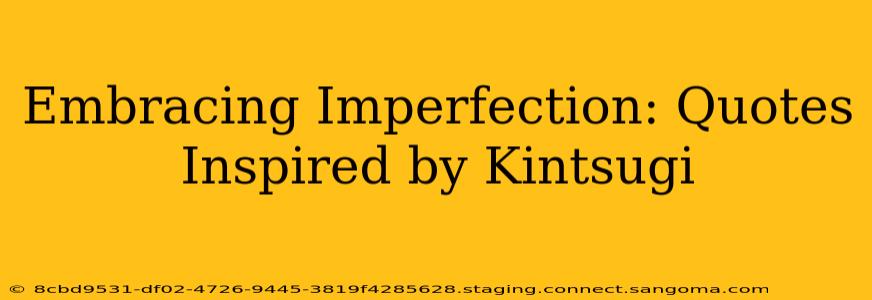Kintsugi, the Japanese art of repairing broken pottery with gold, is more than just a craft; it's a philosophy. It celebrates imperfection, highlighting the beauty of repair and the story a piece holds. This approach to life, embracing flaws and finding beauty in the mended, resonates deeply with many. This article explores the profound wisdom of Kintsugi and presents inspiring quotes reflecting its core principles. We'll delve into the meaning behind the art and how its philosophy can enrich our lives.
What is Kintsugi?
Kintsugi, literally meaning "golden joinery," is a centuries-old Japanese technique of repairing broken pottery with lacquer dusted or mixed with powdered gold, silver, or platinum. Instead of concealing the damage, Kintsugi emphasizes the breaks, making them a focal point of the piece's new beauty. The repaired object isn't simply restored; it's transformed, its history visible and celebrated. This approach transcends the aesthetic; it's a powerful metaphor for resilience, acceptance, and the beauty of imperfection.
Quotes Inspired by the Philosophy of Kintsugi
The philosophy behind Kintsugi offers a profound perspective on life, encouraging us to accept our flaws, learn from our setbacks, and find strength in vulnerability. Here are some quotes inspired by the art, capturing its essence:
"The cracks are not flaws, but rather a testament to the journey. They tell a story of resilience and growth."
"Embrace your imperfections; they are the golden threads that weave the tapestry of your unique life."
"Brokenness is not the end; it's an opportunity for transformation, a chance to shine even brighter."
"Life, like Kintsugi, is about mending the broken pieces, not hiding them. The scars are a part of the masterpiece."
"Don't be afraid to show your cracks; they are proof of your strength and the battles you've overcome."
"Find beauty in the imperfections, for it is in the broken places that light shines through."
"The golden seams of repair are not blemishes; they are symbols of resilience, growth, and the beautiful journey of life."
How Kintsugi Inspires Personal Growth
Kintsugi's philosophy can profoundly impact personal growth:
- Self-acceptance: It encourages accepting our flaws and imperfections, understanding they are part of what makes us unique.
- Resilience: It teaches us that setbacks are not the end but opportunities to learn and grow stronger.
- Perspective: It shifts our perspective, allowing us to see beauty in unexpected places and value the stories our experiences tell.
- Strength: It emphasizes the power of healing and the ability to find beauty even in brokenness.
What are some common misconceptions about Kintsugi?
A common misconception is that Kintsugi is solely about aesthetics. While its visual appeal is undeniable, its deeper meaning lies in the philosophy of embracing imperfection and finding beauty in the repaired. It's not merely about fixing things; it's about acknowledging and celebrating the journey.
How can I apply Kintsugi's philosophy to my life?
Applying Kintsugi's philosophy to daily life involves consciously choosing to embrace imperfection in ourselves and others. It means acknowledging our mistakes, learning from our setbacks, and finding strength in our vulnerabilities. It is about viewing challenges as opportunities for growth and transformation, celebrating our unique journeys, and recognizing the beauty of our scars.
Conclusion: The Enduring Wisdom of Kintsugi
The art of Kintsugi offers a powerful metaphor for life. It teaches us to embrace imperfection, find beauty in brokenness, and see our scars as symbols of resilience and growth. By adopting the Kintsugi philosophy, we can cultivate self-acceptance, build resilience, and live more meaningful lives. The golden threads of our past experiences weave a tapestry of strength and beauty – a testament to our journey.

